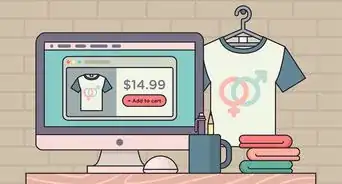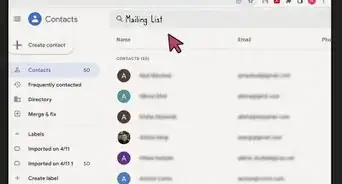This article was co-authored by Christina Santelli. Christina Santelli is the Owner and Founder of Style Me New, a wardrobe styling concierge based in Tampa, Florida. She has been working as a stylist for over six years, and her work has been featured in HSN, the Pacific Heights Wine and Food Festival, and the Nob Hill Gazette.
There are 9 references cited in this article, which can be found at the bottom of the page.
wikiHow marks an article as reader-approved once it receives enough positive feedback. In this case, 93% of readers who voted found the article helpful, earning it our reader-approved status.
This article has been viewed 37,943 times.
Starting a fashion business may seem like a glamorous career choice. You may think its all about beautiful models, fun parties, and a chance to showcase your talent to the world. But starting a fashion company is more often a life of hard work, long hours, and a lot of blood, sweat, and tears. To create a successful fashion company, you need to work hard and create a unique style that will take your company to the top.
Steps
Understanding the Fashion Business
-
1Be aware the fashion world is competitive and unforgiving. Starting any type of business requires patience, endurance, and dedication. But setting up a fashion company is all the more challenging because fashion is a very competitive industry. Almost everyone wants to be a fashion designer these days. But the industry is difficult to break into and quick to turn its attention to the next big thing.[1]
- Your roles as a designer and owner will also require a lot of multi-tasking and time management. You will be expected to start up the business and manage your raw materials and fabrics. You will also need to come up with a business plan, find a manufacturer, and maintain your customers and suppliers.
-
2Do research on your favorite brands and companies. Read articles and interviews with the owners of your favorite brands and companies. Visit the flagship stores of a company or brand that could serve as a model for your company.[2]
- Building your brand, distributing your product, and maintaining your sales are all important to the success of your company. So research these aspects before you jump in.
- You may also want to enroll in a basic business course or fashion merchandising course at your local college or online.
Advertisement -
3Assess your skills as a business owner. Unless you are super human, you will not be able to fulfill all the roles required to be a business owner on your own. Do a self assessment of your skills to determine where your strengths and weaknesses lie. From there, you can figure out if a business partner or an accountant might be worth the investment to help your business succeed.[3]
- Make a list of skills you feel confident you have and skills you may need help with, or may need someone else to do for you. This could be a skill as simple as “design” and as detailed as “financial management”.
- Just because you have a design degree does not mean you have all the skills to run a fashion company. The design process in a business is different from the design process in school.
- Running a fashion company means developing a creative process that works for you and works for your business. So this means you may need to bring in other individuals to help you develop and grow your company.
-
4Think about the contacts you have in the fashion industry. Part of the industry is who you know. Don’t be afraid to seek out a mentor, a benefactor, or a peer who can help you develop your business.[4]
- Reach out to a more experienced mentor to get advice about how to begin your business. An internship at a large fashion company you admire can help you realize how to use your skill set to be successful as a business owner.
- Many smart designers find a business partner they can trust. Look for a partner who brings business skills and connections to the table. This could be a spouse or partner, a family member, or a close friend. A business partner is a person you can lean on in difficult times and will allow you to focus on the creative aspects of your business.
- Another key contact is a PR person, or Public Relations guru. They will help you promote and grow your company.Find a PR person who believes in your company and will provide their services to you for a discounted fee.
- You will also need other professionals. Such as accountants, lawyers, stylists, photographers, graphic designers, production managers, and interns. Ask yourself if you already have a set of contacts you can use to fill these roles, at least in the early stages of the business.
- If you don’t have these contacts, you will need to network at fashion events and meet people that can help you start your business.
-
5Treat your company like a business. Like any business, you need to think like an entrepreneur from the very beginning. This means putting together a business plan that lays out short-term and long-term goals. You will also need to act like a professional to everyone involved, from your business partner to your stylist.
- Be honest about your skills and limits as a business owner. This will help you to build solid working relationships with manufacturers, buyers, and investors.
- Let your passion for design fuel your fashion company. Don’t be limited by a lack of money or contacts. Take the story of British designer Christopher Kane. Early in his career, Kane borrowed £300 from his Grandmother to buy fabric for his collection at Central St. Martins, a top design school in London. There was a wealthy student in Kane’s year who spent a large amount of money on his collection. But Kane has gone on to become successful, while the other wealthy student has not. So Kane’s passion and drive are what made him succeed, not access to money.[5]
Creating Your Company’s Brand
-
1Think about how your company fits in the current market. Its important to focus on a style and brand for your company that is different than what is already available in the market. One unique item, like Diane von Furstenberg’s wrap dress or Converse High Tops, can make or break a fashion company.[6] [7]
- Ask yourself why people will buy your product over some else’s product. Is it the design, the price, the value, or the brand they are buying into?
- For example, maybe you’d like to start a fashion company that designs socks. So you ask yourself, what makes your sock designs so unique in a market flooded with other sock designs? It could be the socks have a cool design. Or they are a great price for the quality of the socks. Or they feature illustrations from another established brand that you are collaborating with.
-
2Consider your target market. Who are you designing for? And why? This seems like a basic question. But the more specific and clear your answer is, the better you can create and market your product to your target market.[8]
- Think about if your product is for men or women, adults or children, a younger market or an older market.[9]
- You can also consider your target market from a psychological perspective. Get in the mind of your customer and understand how your product or design will fit into their lifestyle. Will they wear your designs for a specific occasion or event? What will make them buy your design?
- Understand their psychology, emotional needs, and relationship with clothing. Think about how your design makes their lives better.
-
3Create a prototype. Do this by first sketching out your designs on paper or on an iPad. If you aren’t great at sketching, ask a friend with illustration skills to sketch out your designs for you.
- From the sketch, create a prototype to show potential buyers. You can outsource the creation of the prototype, but this can be expensive.[10]
- If you are design oriented, you may be able to create your own prototype garment or product.
Funding Your Company
-
1Create a business plan. One of the main purposes of a business plan is to secure funding for your company, through a bank loan or an investor. The other purpose of a business plan is to document your vision and objectives for the company.[11] [12]
- Think of the business plan as a roadmap for how the company is going to evolve and grow to achieve its vision. It contains the budget and projections for your business, as well as finances and ways to grow your funding.
- The business plan is a living document that may adjust or change based on how your company develops over time.
-
2Secure investors and partners in the company. How you fund your company will affect the level of debt you will need to pay down once your company gets off the ground. There are two types of funding:[13]
- Money from equity investors. Also called venture capitalists or “angel investors”. These investors provide cash to invest in your company. They also share ownership of the company with you. They are investing in the hopes your business will grow and turn a profit. Investors can offer you resources and expertise to improve your business. But if you disagree with your investor on an aspect of the business, then you may have issues with the investor, and with your cash flow. So look for an investor who is aligned with your strategy and who has the industry experience to help your business grow.
- Money via a bank loan. This type of funding doesn’t come with any investors to answer to. But you will need to pay back the money you have borrowed, plus interest. So the cash flow of your business will need to account for monthly payments on your loan and interest. If you miss any payments, you may end up getting angry calls from the bank.
- Taking on too much debt can drive your business to bankruptcy. So its important to account for your debts and pay them off before the profits are used elsewhere in your company.
-
3Look for other sources of funding. Family and friends who believe in you are options for funding. Many organizations off grants, sponsorships, and awards to nurture new design talent.
- Another way to raise funds for your company is to start a Kickstarter fund to promote your product and crowd source your funding.
Manufacturing and Distributing
-
1Source your materials. Create relationships with fabric companies and supply companies. Look for materials that fit your needs but won’t break your budget.
- Depending on how many products or items you are planning to produce, you may need fabric in bulk. Or you may need to take your prototype to a manufacturer.
-
2Find a manufacturer or producer. New companies often struggle with production. You will likely be ordering in small quantities at first, which will leave you in a poor bargaining position with manufacturers. They may ask you for a deposit before you receive payment from a retailer.[14]
- Factor in an upfront deposit to the manufacturer in your business plan. You don’t want to delay production and deliver late to your retailers, as this could damage your working relationship with them.
-
3Seek out distributors. These could be online shops or local shops in your area. Look for sellers who appeal to your type of buyer. Don’t be afraid to send samples out of your product to peak the interest of distributors. But be smart about going after distributors that you think will fit with the style and brand of your fashion line or product.[15]
- If you plan to sell your work online on sites like etsy, keep in mind it may be difficult to stand out among the thousands of products available on that site. But it's a good way to ease into the online selling world.[16]
- Once your fashion company becomes more established, consider creating your own website for your company. Doing this will allow you to maximize your profits and give you direct access to your customers.
Promoting Your Company
-
1Use social media to your advantage. Think about how your clothing line or product fits with social media. If you’re promoting your high end sock line for women, for example, you may not use Facebook to promote your brand. Instead, you may use Instagram or Pinterest. These social media sites can show off the beauty and design of your socks. These sites also target a certain market that you may be trying to reach.[17]
- Instagram is a great platform for small brands to show off their products. It’s visual and allows you to continually promote your brand. But it's a hard place to drive sales right now, as it currently does not allow live links in image captions.
- Choose your social media platforms carefully. Update the company accounts on these sites often and post regularly. Respond to customer comments or re posts. These platforms are all about creating a conversation, after all. So listen to your followers and gather important feedback from them.
-
2Evolve your clothing line or product every season. Just like the change from spring to summer, your fashion company should produce new products every season. Whether it's a new collection or a few small tweaks to an existing collection, its important to continue evolving your company’s brand and style.
-
3Listen to your customers. Its important to listen to what your target market wants from your clothing line or product. Don’t be afraid to depart from your original ideas and designs, based on customer feedback.[18]
- Get customer input before making major changes. If you modify your brand, do it slowly, over time so you don’t freak out your customers.
- Ultimately, listen to your design instincts as well as customer feedback. While you should never ignore your customers’ needs or wants, its important to always be true to your design aesthetic and personal approach to fashion.
Expert Q&A
-
QuestionHow do you grow in the fashion industry?
 Christina SantelliChristina Santelli is the Owner and Founder of Style Me New, a wardrobe styling concierge based in Tampa, Florida. She has been working as a stylist for over six years, and her work has been featured in HSN, the Pacific Heights Wine and Food Festival, and the Nob Hill Gazette.
Christina SantelliChristina Santelli is the Owner and Founder of Style Me New, a wardrobe styling concierge based in Tampa, Florida. She has been working as a stylist for over six years, and her work has been featured in HSN, the Pacific Heights Wine and Food Festival, and the Nob Hill Gazette.
Professional Stylist Learn to pivot so you can go into different markets. You have to understand the culture where you are, and what people are wearing in the area. The market in San Francisco, for instance, is completely different than it is in Tampa."
Learn to pivot so you can go into different markets. You have to understand the culture where you are, and what people are wearing in the area. The market in San Francisco, for instance, is completely different than it is in Tampa." -
QuestionWhat do fashion designers wear?
 Christina SantelliChristina Santelli is the Owner and Founder of Style Me New, a wardrobe styling concierge based in Tampa, Florida. She has been working as a stylist for over six years, and her work has been featured in HSN, the Pacific Heights Wine and Food Festival, and the Nob Hill Gazette.
Christina SantelliChristina Santelli is the Owner and Founder of Style Me New, a wardrobe styling concierge based in Tampa, Florida. She has been working as a stylist for over six years, and her work has been featured in HSN, the Pacific Heights Wine and Food Festival, and the Nob Hill Gazette.
Professional Stylist If you want to start your own fashion business, always dress in a way that would make people want to hire you.
If you want to start your own fashion business, always dress in a way that would make people want to hire you.
References
- ↑ http://www.businessoffashion.com/articles/basics/the-business-of-fashion-basics-1-setting-up-your-own-fashion-business-what-do-i-need-to-know-first
- ↑ http://www.businessnewsdaily.com/5147-how-to-start-clothing-line.html
- ↑ http://www.businessoffashion.com/articles/basics/the-business-of-fashion-basics-1-setting-up-your-own-fashion-business-what-do-i-need-to-know-first
- ↑ http://www.businessoffashion.com/articles/basics/the-business-of-fashion-basics-1-setting-up-your-own-fashion-business-what-do-i-need-to-know-first
- ↑ http://fashionista.com/2014/05/tips-starting-fashion-business
- ↑ http://www.businessnewsdaily.com/5147-how-to-start-clothing-line.html
- ↑ http://www.marieclaire.com/culture/a7896/how-to-start-your-own-clothing-label/
- ↑ http://www.businessoffashion.com/articles/basics/the-business-of-fashion-basics-1-setting-up-your-own-fashion-business-what-do-i-need-to-know-first
- ↑ http://www.entrepreneur.com/article/37944
- ↑ http://www.marieclaire.com/culture/a7896/how-to-start-your-own-clothing-label/
- ↑ https://www.wikihow.com/Write-a-Business-Plan
- ↑ http://www.businessoffashion.com/articles/basics/the-business-of-fashion-basics-2-what-is-a-business-plan-for-and-how-do-i-go-about-writing-it
- ↑ http://www.businessoffashion.com/articles/basics/the-business-of-fashion-basics-3-how-do-i-find-the-right-investors-and-partners
- ↑ http://fashionista.com/2014/05/tips-starting-fashion-business
- ↑ http://www.businessnewsdaily.com/5147-how-to-start-clothing-line.html
- ↑ http://www.marieclaire.com/culture/a7896/how-to-start-your-own-clothing-label/
- ↑ http://www.businessoffashion.com/articles/basics/the-basics-part-8-marketing
- ↑ http://www.businessnewsdaily.com/5147-how-to-start-clothing-line.html













































































